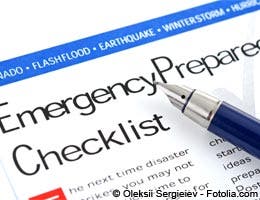How to Prep for Natural Disasters
by Martin B, Survival Blog:

Various types of natural disasters happen around the world every day. While you can make general preparations for emergencies, there are plenty of specific things you’ll need to do to ensure you and your family weather a crisis safely. Here’s how to properly prep your home for any event.
GENERAL PREPARATIONS FOR SHELTERING IN PLACE
When a disaster strikes, you’re generally going to do one of two things. You’re either going to shelter in place, or you’re going to evacuate. What do you need to make sure you have on hand if you’re staying in place?
- Food: Have at least a few days’ worth of nonperishable foods available, as well as tools for cooking if electricity is off.
- Water: Store at least three days of water for each person and animal in your household, as well as the means to purify more if necessary.
- First-aid and medicine: Keep a fully stocked first-aid kit and a supply of any necessary prescription and over-the-counter medications.
- Hygiene: Toilet paper, toothpaste and toothbrushes, soap, and other hygiene supplies will be necessary, especially if you can’t make a trip to the store.
- Alternative power sources: If the electricity goes out, you’ll need alternative sources to charge phones and power appliances.
- Fuel: Make sure your car’s tank is full, and have some gasoline stored in case gas stations are inaccessible. If you use a generator, you will also need fuel for that.
- Ammo: If you have firearms in your home, make sure you’re stocked up on ammo, just in case.
- Lighting: If the power is out, you’ll need alternative light sources. Stock up on flashlights and batteries.
- Cash: ATMs will likely be inaccessible, and if stores are open, they may not be able to run debit or credit card transactions. Having cash will make it easier for you to get the things you need.
- Pandemic supplies:Due to recent events, it’s also recommended to add masks, gloves and sanitizer to your emergency kit, especially if you’re going to be leaving the house.
If you’re sheltering in place, having these things on hand will make the situation easier to bear, especially if it takes a while for things to get back to normal.
GENERAL PREPARATIONS FOR EVACUATIONS
If you’re in the path of a dangerous natural disaster and it isn’t safe to shelter in place, your only other option is to evacuate to a safer locale. In these events, you’ll want to ensure you have everything listed above stored in your vehicle, as well as:
- A change of clothing: You’ll need at least a few changes of clothing for each person in your family. Ensure they’re appropriate to the season.
- Important documents: Birth certificates, car and house titles, insurance policies, and any other essential documents should be included in your evacuation kit. Keeping electronic copies of these stored in the cloud is also a good idea.
- An evacuation plan: Before evacuating, make sure you know where you’re going and how you’re going to get there. If your family gets separated, make sure everyone knows where you’re supposed to meet up.
- Anything you can’t live without: include pictures, irreplaceable items and items with sentimental value in your evacuation kit, especially if your home might be damaged or destroyed.
These are very general suggestions for what you might need to help you make your way through a natural disaster. Let’s take a closer look at specific threats and what you need to do to prepare for them.
PREPPING FOR HURRICANES
Coastal areas along the Atlantic Ocean and the Gulf of Mexico are prone to hurricanes — massive storms that can deliver rain, storm surge and winds that range anywhere from 74-155 mph. If you’re unprepared, these storms can be devastating.
If you’re sheltering in place:
- Clean up your yard and remove anything that could become flying debris in high winds. This includes lawn furniture, potted plants and any other ornamentation you have in your yard.
- Trim tree branches away from your home, and remove any dead limbs that could fall and cause damage.
- Cover any large windows with plywood or storm shutters.
- Be prepared for extended power outages.
- Pay close attention to local weather reports and the path of the storm so you can determine whether evacuation will be necessary.
If you have to evacuate — either because you live in a mobile home or a flood zone:
- Shut off water and power to your home before leaving.
- Ensure you have everything you need, because it may be some time before you’re allowed to return.
- Follow your outlined evacuation route and keep moving until you’re out of the path of the hurricane.
- Find somewhere to shelter and ride out the storm.
Hurricane season starts on June 1 and lasts until Nov. 30, so it’s a good idea to start preparing before the first storms start popping up on the radar.
PREPPING FOR TORNADOES
Unlike with hurricanes, you don’t generally get a lot of warning before a tornado strikes. According to the NOAA, the average lead time for a tornado warning is only 13 minutes. That means you need to be ready anytime the weather turns foul, and have everything you need to survive this natural disaster.
- Know where you’re going to ride out the storm. In areas that are prone to powerful tornadoes, this will likely be shelter or basement. In areas where these aren’t common, you need to get to the center of your home, as far away from any windows as possible.
- Stock your shelter with emergency supplies. This will be essential if you find yourself trapped after a tornado by debris piled on your exit.
- Stay informed about changes in the weather and be ready to move at a moment’s notice.
- Be ready for extended power outages, especially if the tornado damages essential infrastructure.
Tornadoes can appear anytime there is a bad storm, so make sure you’re aware of what the weather is doing in your area.
PREPPING FOR EXTENDED POWER OUTAGES
Sometimes, even if there isn’t a natural disaster to cause a problem, we may find ourselves without power for extended periods. Depending on the location and the time of year, this can vary from mildly inconvenient to downright dangerous.
For power outages in hot climates:
- Open your windows and try to get as much airflow in your home as possible.
- Stay hydrated. Even if you’re not active, if it’s hot outside, you will need to drink more water to stave off dehydration.
- Spend time outside in the shade. Believe it or not, without power and air conditioning, it will usually be cooler outdoors than in.
- If you use generators to power appliances, make sure they’re positioned outdoors or in a well-ventilated area.
For power outages in cold climates:
- Keep doors and windows closed as much as possible. Your home is designed to keep heat in, so let it do its job.
- Look into alternative heating sources that don’t rely on electricity. This could include furnaces that burn natural gas or pellet fuels, depending on what is available in your area.
- Layer your clothing. Multiple thin layers allow you to add or remove items depending on your comfort levels.
- Clean and maintain your chimney before you need it to warm your home. A clogged or dirty one can be dangerous or even present a fire hazard.
In both climates, you’ll want to have a supply of nonperishable foods or a generator to power your refrigerator to ensure you’ve got enough to eat during this disaster.
PREPPING FOR EARTHQUAKES
We live on a tectonically active planet, which means many areas are prone to earthquakes. If you live in one of these places, it’s generally safe to assume that the building you’re in is rated for quakes. Still, there are plenty of things you need to have inside your home to prepare, including:
- Ride out the earthquake under a large table or another heavy piece of furniture.
- Keep a pair of rubber-soled shoes with closed toes handy. These will protect your feet from broken glass and other damage.
- Secure anything that’s hanging from the walls to keep it from shaking loose, especially if it’s over your bed.
- Secure heavy appliances to wall studs to keep them from tipping over.
- Know where all your utility shutoffs are and be prepared to turn them all off in the event of an earthquake.
- Have a bug-out-bag ready if you need to evacuate your home because the quake rendered it unsafe.
You will have little to no warning before an earthquake, so you must be ready for a disaster and know what you need to keep yourself and your family safe.
Loading...



